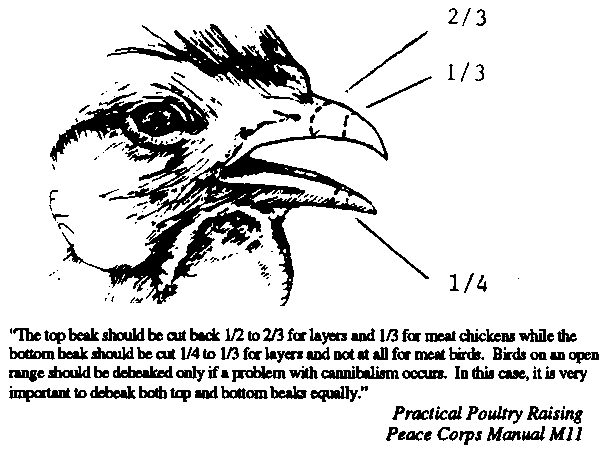From UPC:
American poultry and egg producers using battery cages and crowded floor systems remove one-half to two-thirds of the birds' beaks to reduce "cannibalistic" pecking. Cannibalism is a distorted behavior pattern in domestic fowl and game birds reared in captivity resulting from the abnormal restriction of the normal span of activities of a healthy, secure, ranging fowl. It includes vent picking, feather pulling, toe picking, and head picking. Diseases of Poultry, 8th ed. States that "A different form of cannibalism is now being observed in beak-trimmed birds kept in cages. The area about the eyes is black and blue with subcutaneous hemorrhage, wattles are dark and swollen with extravasated blood, and ear lobes are black and necrotic." p.741.
Mason & Singer, Animal Factories, 1990, p. 39, note de-beaking started around 1940 when a San Diego poultry farmer found if he burned off the upper beaks of his chickens with a blowtorch, they were unable to pick and pull at each other's feathers. His neighbor adopted the idea but used a modified soldering iron instead. A few years later a local company began to manufacture the "Debeaker," a machine that sliced off the ends of birds' beaks with a hot blade. Broiler chicks are debeaked once because they're slaughtered before their beaks can grow back. [Some broiler producers no longer debeak, relying instead on youth, lethargy, and dim lighting to control behavior.] Laying hens and breeding flocks are debeaked, sometimes twice, during the first week of age and sometimes again between 12 and 20 weeks of age. It is recommended that turkey poults be debeaked between two and five weeks of age. Ducklings and goslings are debilled by slicing off the forward edge of the upper bill with an electric debeaking machine. An operator debeaks 12 to 15 birds a minute.
Lyon Electric Co., of Chula Vista, CA, touts its 6-10 day old precision beak trimming method as the most popular type used today to trim breeder and layer chicks, noting "Failure to beak trim properly can damage bird livability and uniformity. It can cause starve outs, feed wastage and even the cannibalism it was to prevent. This adds up to lost profits."
"If an electric beak trimmer is not available, a temporary form of trimming can be done by using a sharp jackknife." Diseases of Poultry, 8th ed, p. 743.
Some poultry scientists and other poultry industry representatives say opposition to debeaking is based "more on emotion than research." In fact, debeaking was fully explored by the Brambell Committee, a group of veterinarians and other experts appointed by Parliament to investigate animal welfare concerns arising from intensive farming in the early 1960's. The committee wrote in 1965: "There is no physiological basis for the assertion that the operation is similar to the clipping of human finger nails. Between the horn and bone [of the beak] is a thin layer of highly sensitive soft tissue, resembling the quick of the human nail. The hot knife blade used in debeaking cuts through this complex horn, bone and sensitive tissue causing severe pain."
In 1990, in "Behavioral evidence for persistent pain following partial beak amputation in chickens," published in Applied Animal Behavior Science, Vol. 27, Michael Gentle and his associates at the Institute of Animal Physiology and Genetics Research, Edinburgh, Scotland, showed that experimentally debeaked chickens demonstrated chronic pain and suffering following the operation. Gentle explains: "The avian beak is a complex sensory organ which not only serves to grasp and manipulate food particles prior to ingestion, but is also used to manipulate non-food articles in nesting behavior and exploration, drinking, preening, and as a weapon in defensive and aggressive encounters. To enable the animal to perform this wide range of activities, the beak of the chicken has an extensive nerve supply with numerous mechanoreceptors, thermoreceptors, and nociceptors [ nerve endings sensitive to mechanical pressures, heat and pain]....Beak amputation results in extensive neuromas [tumors] being formed in the healed stump of the beak which give rise to abnormal spontaneous neural activity in the trigeminal [threefold] nerve. The nociceptors present in the beak of the chicken have similar properties to those found in mammalian skin and the neural activity arising from the trigeminal neuromas is similar to that reported in the rat, mouse, cat and the baboon. Therefore, in terms of the peripheral neural activity, partial beak amputation is likely to be a painful procedure leading not only to phantom and stump pain, but also to other characteristics of the hyperpathic syndrome, such as allodynia and hyperalgesia [the stress resulting from, and extreme sensitiveness to, painful stimuli]."
Gentle and associates compared 5 behaviors in 16 experimentally debeaked Leghorn hens with the same behaviors in a control (nondebeaked) group of hens: number of bill wipes, head shakes, drinking movements, pecks directed to water and floor, and pecks directed to cage sides. In their experiment, "Partial beak amputation produced a number of significant alterations to the behavior of the birds. The birds pecked less at the environment after amputation than before and this difference can be interpreted as guarding behavior of a painful area of the body, similar to that seen in man and other animals....Guarding behavior can also be used to explain the reduction in head shaking and beak wiping following amputation. Head shaking is a behavior commonly associated with feeding and drinking and, like beak wiping, it functions to remove food particles or irritant substances from the mouth or surface of the beak....The modifications in the pecking and drinking behavior of birds following partial beak amputation [conforms with other reports] that partial beak amputation results in long-term (56 weeks) increases in dozing and general inactivity, behaviors associated with long-term chronic pain and depression."






